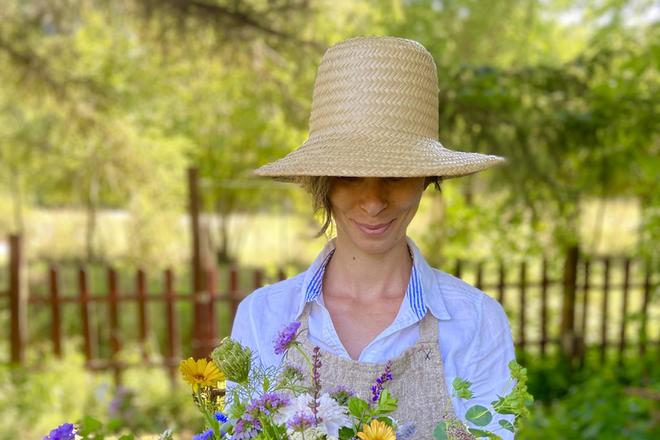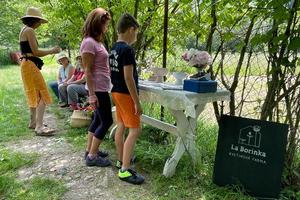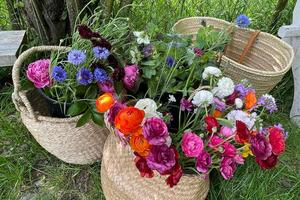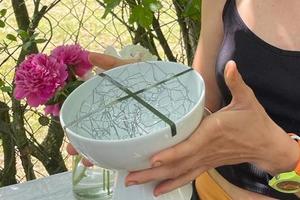When buying a bouquet in a traditional flower shop, the flowers might have travelled tens of thousands of kilometres and grown under artificial conditions. However, exquisite flowers can be grown, ecologically and sustainably, in Slovakia as well. One piece of evidence is the small flower farm near Bratislava, in the tiny village of Borinka. It was launched by Daniela Baños and her husband Hernan, originally from Argentina. This is why its name, La Borinka, has a Spanish touch.
“We wanted to offer locally grown flowers as an alternative to commercially grown flowers from imports,” Daniela Baños explained during the Weekend of Open Parks and Gardens, an event during which the farm opened its gates to visitors why they decided to start a flower farm. “You can grow beautiful cut flowers in Slovakia. The season is from April until the first frost.”
They drew inspiration mainly from the UK, where there is a longer term trend for flower farms. One reason for this is that after Britain left the European Union, the transport of cut flowers became so much longer that some of them may not even have survived the journey. Another reason is the change of people’s mindset, who now prefer to buy organically and locally grown flowers.
“During a workshop in England, we discovered that a flower farm can work effectively on a small plot of land like ours, without large greenhouses,” said Baños. “So, we went for it.”
Today they grow seasonal cut flowers for bouquets and arrangements in the open air and use environmentally friendly techniques. They grow a wide variety of types of flowers. Traditional varieties of cut flowers, special varieties but also meadow flowers, which are close to the surrounding landscape and produce pollen.
It started with a flower meadow
The couple moved into the house built on the land where her grandparents’ house stood in Borinka in 2020. The very first year they planted a flower meadow in the old apple orchard next to the house. As they were fascinated by the meadow flowers that grew there, they gradually added more areas of [1] flowers intended for cut flower production. The natural next step was to share this beauty with the wider community. They began to create bouquets from the flowers, which at first mainly went to family members, acquaintances, friends, neighbours and work colleagues.
“Organically grown flowers with the touch of wildness are beautiful, ” said Daniela Baños, who studied sustainable development and ecology. “You can feel the freshness, authenticity and nature.”
Then came the first orders for bouquets and the final decision to start a flower farm. Today, they call 2021 year zero. They tried “flower farming” for their own pleasure. The following year they went fully into business. This year they have already rented, a few steps from their house, two more fields. On one they grow flowers and plants for drying and on the other dahlias, a popular flower in Slovakia.
They offer locally grown flowers as an alternative to commercially grown flowers from imports, which often travel thousands of kilometres and lose their wildness and fragrance due to preservatives and growing technology.
“If someone wants tulips in August, we won’t satisfy them,” said Daniela Baños. They don’t buy tulips in a wholesale warehouse for such customers. “We tell them that though we’re sorry, we just don’t work that way. We offer them an alternative and explain the advantages of seasonal flowers.”
Ecologically and sustainably
The couple tried the digging and no-digging method when setting up beds for future flowers. They ploughed one part of the plot, pulled the weeds by hand and brought in compost. The other part was mowed. Then they layered cardboard and compost on it.
“Establishing beds with the digging method is very time-consuming and establishing beds with the no-digging method is a big burden on your wallet, because you need tons and tons of organic compost you have to buy, import and layer into the beds,” said Baños, adding that the no-dig method is kinder to the soil and life in it.
They pull the weeds by hand while Daniela’s mother helps them with this.
“My mom is a big help to us, whether it’s keeping the weeds to a manageable minimum or helping with the bookkeeping,” Daniela Baños revealed the details of the farm’s operation.
They plant the flowers very close to one another for a special purpose.
“The plants grow high, which suits us because we need long stems for making bouquets,” she said. “Moreover, such a dense stand retains moisture and weeds grow at the acceptable amount. Only at the beginning do we have to take care that the weeds do not outgrow the flowers.”
Today, they grow annual flowers in one bed and perennials such as marguerites, ornamental garlic, yarrow, and tanacetum and many others. In a bed next to the fence they grow roses, David Austin Roses. Apart from the fact that they do not suffer from any diseases, these roses smell beautifully. Which may no longer be the case with “technologically” grown roses.
“Technologically grown roses – planted in a special solution, tied up, with ideal lighting and climate – lose their fragrance. They have not yet figured out why this happens,” Baños said.
They plant flowers almost all year round, with the biggest amounts in autumn and spring.
“We plant all the hardy annuals in autumn, something my grandmother never did in her life,” she said.
The biennials planted in September manage to root sufficiently by November to overwinter successfully. By spring, the flowers think they have had one year and start flowering.
“That’s the secret of autumn planting. The biennials don’t block your flower bed for a year,” explained Baños.
The flower beds occupy about 350 square metres. The rest are grass paths and some parts are left unattended. These wild sedges are important for insects and small predators. Here they find refuge and a place to reproduce. In this way, they try to maintain a balanced ecosystem. Also, they need to be very efficient. As soon as one flower species has bloomed out and the soil has rested topped with organic compost and fertilised,[8] they plant something new in the emptied flower bed.
“We always try to keep all the beds occupied,” she said, adding that they usually rotate flowers in one bed twice a year, some even three times.
The couple leave the roots of the flowers they have already cut in the ground. They do not spade the soil, they just aerate it with a pitchfork.
“We plant the new plants next to the old roots. This is because micro-organisms are attached to them, which then makes it easier for them to colonise the new plant,” she said.
They fertilise with nettle infusion, a leachate made from the droppings of llama alpaca, and comfrey infusion.
“Nettles contain a lot of nitrogen and supply nutrients to the flowers during the growing season to build lots of green, resilient and healthy tissue. We use comfrey during the flowering season, because it contains a lot of potassium and the plants use this to produce beautiful flowers,” explained Baños.
The head gardener is Hernan. Thanks to him, the beds have precise dimensions and markings. Daniela is in charge of planning what to plant next season, marketing, arranging bouquets and communication with clients.
Growing the flowers, however, is the easier part of their business. The harder part is selling the flowers.
“At first glance, growing flowers can seem very romantic, but it requires a lot of education in different areas, very good planning, very good customer service, thoughtful logistics and marketing,” said Baños.
Bouquets ordered at least a day in advance
La Borinka flower farm does not operate like a standard flower shop. They don’t keep flowers in “stock”, but cut them from the beds to create ordered bouquets and arrangements.
“Inside the bouquets we put what is blooming the most beautifully in our flowerbeds right now,” said Daniela Baños.
That is why they already think about the composition of future bouquets when planning a new season.
“If you want to have a nice bouquet, you have to have the main flowers, complementary flowers and greenery,” Baños explained the basics of arranging.
They cut the flowers for the next bouquets early in the morning or late in the evening when it is cool and they are full of water. The flowers go into the dark and cold for 12 hours to hydrate. They immerse the stems of some flowers, such as poppies or carinthe, mint and such, in boiling water for a few seconds after cutting. This closes the coils and the flowers will last longer, Baños revealed one of the secrets behind successful arrangements.
She ties the bouquets of flowers treated this way the next day.
“If someone calls me and says they want a bouquet right away, we may not be able to accommodate them,” she said, adding that for now they mainly arrange bouquets based on orders at least one day in advance. Customers can pick them up at their farm or at contact points in Stupava and Bratislava’s Záhorská Bystrica.
When arranging the flowers for weddings and events, they do not use florex, a popular floral foam which can absorb and hold a lot of water. However, it is neither reusable nor recyclable. It produces microplastics and releases harmful substances, stressed Daniela Baños.
“We decided not to use this material in our arrangements,” she said. Instead, they use metal “hedgehogs” or plain metal mesh. They also create wreaths from living and dried plants, no plastic or glue, maybe just a metal wire. After removing the metal wire they are completely compostable.
Along with growing flowers, they carry out educational activities. They organise various workshops on the sustainable cultivation and arranging of flowers, as well as courses to get more and more people to swap their lawns for flower beds.
“It’s good for nature and good for people,” she said, adding that this increases biodiversity.
What’s next
For now, the flower farm cannot support them both, though in the future, with efficient operation, it might. But their ambition is not to have dozens of employees and a huge farm.
“Our goal is a sustainable business which will fit our lifestyle because the planet has its limits,” said Baños. “We as humankind should instead step back from our needs.”





